Devoted to the work of Max Neuhaus (1939-2009), Max Feed. Œuvre et héritage de Max Neuhaus at Frac Franche-Comté, Besançon, the first retrospective since the death of this major figure, brought together an important documentation as well as the only non-site specific of his sound works. As a way of looking for Max and make his thinking resonates, works from today’s artists have been cautiously selected by the curator Daniele Balit, working for years on Neuhaus work and preparing (together with Mathieu Saladin) an edition of collected writings and interviews*.
The work of Max Neuhaus largely deserves a new examination, not only for its intrinsic quality, but also as a way to measure some changes in the appreciation of sounds in the art world (from field recordings to narrative sound editing, to music as a topic). Sound artists, one they accept such a name or label, usually find a legitimacy through their previous or parallel activity in the music scene. Any sound recorded by a famous artist receives more recognition than an ambitious sound installation from a historical figure. We, the public of art, have usually not so much time to listen carefully and what is usually expected from us is more a reaction to something to hear, either we identify the sound and its origin or have to read something to know what is all about. Are we able of a critical approach to sound installation, as we do not really know much about what to connect it and usually do not trust our ears as we trust our eyes? We are not at ease, to say the least, when we try to share our aural experiences by using some visual metaphors at hands. These are evidences must they must be kept in mind. For thinking about sound installation as a specific artform, Neuhaus work helps us greatly; moreover, we certainly cannot do without him. Max Neuhaus was a radical at a time when it was the only possible to exist and find a way through the art scene. He had the power to convince and got recognition from major curators, musicologists and critics though he did not do music and created sound pieces that slowly grew in a non-remarkable way before being short cut and be reminded through what he described as a transparent aural afterimage. Part of the limitation for a larger recognition of his importance was probably due to his position of loner and to his rejection of theory as synonym to claim for a certain place in art history.
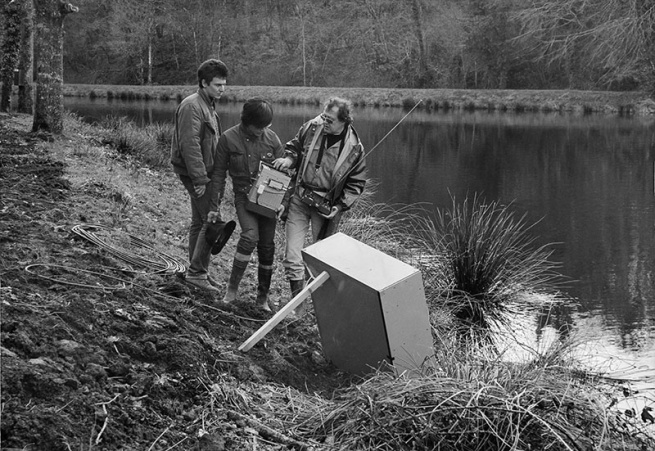
Max Neuhaus at Domaine de Kerguéhennec, Locmine, France, 1986. Ph. Florian Kleinefenn
What is the meaning of active listening? Couldn’t we say that any music lover is also a practitioner of active listening? What is the difference between the position of Cage and the one of Neuhaus? Cage, for sure, want to make us believe that everything is music or could be music. For Max Neuhaus, who has deserted music and music world, our perception of a new sound, the way we are able or not to dissociate it from the original soundscape is what makes of us auditors/spectators of his work. To think that one of his ultimate pieces was done for a Synagogue and that it played the part of some chime, a chime, a bell frome the 20th Century give us the impression that it was maybe more important for him to find for them a place in the soundscape of his time, a craftsman more than an author with a masterplan. In fact, since the beginning of his researches, he related his Time Pieces to daily life. Was art for him an act of faith? Most probably, writing as early as 1989: "A key idea of these works is their integration into the life of their communities - that they become unifiers, spiritually tying together a community’s diverse places and activities momentarily throughout the day".
On more than an occasion, Neuhaus compared his work to one of a sculptor and that was much more than the easiest metaphor which comes to mind. With the passing of time, and now that we are sure that this question will stay unanswered, it pleases us far more to consider that there was something so specific in what he wanted to make us hear and feel, that he could not use the usual comparisons we associate with music and sounds, neither visual nor spatial. Coming back to Cage and Feldman who both, in different ways, were asking for our attention, we could say that Neuhaus refused to produce music or original sounds in order to make us nearly grasp (as a present given in a dream) how a particular sound infiltrates our surroundings to find a way to our mind. A real move, I mean. Neuhaus once proposed a book for onestar press publishing house: the same photograph on each page: a close-up of his left ear, but with less and less ink until the picture slowly disappear or fade away. This modest publication could well figure out as a manifesto.
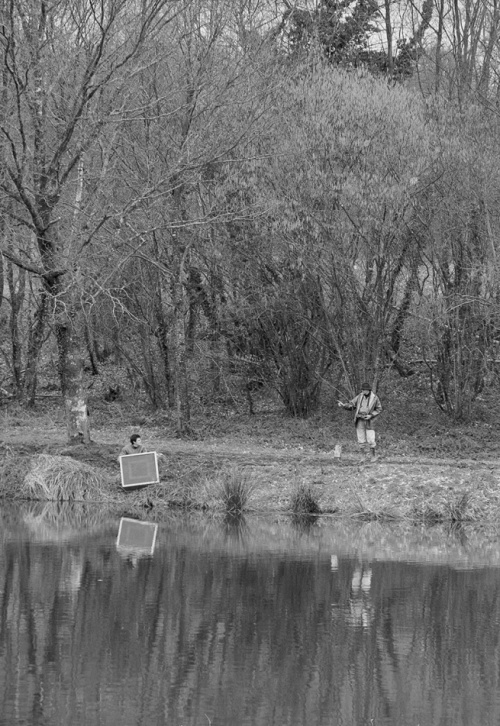
Max Neuhaus at Domaine de Kerguéhennec, Locmine, France, 1986. Ph. Florian Kleinefenn
The curator of this exemplary exhibition, arguably posits the ecological and political dimensions of the work. Obviously, we must make a real distinction between theTimes Square piece and what comes after. Times Square is a masterpiece, and could be nothing else as the Dia Art Foundation has make it possible to reactivate it and make it function permanently. In Times Square you get everything, from the para-sitism, to the dematerialized work, from open access to absence of constraint; the piece could remain unheard, as well as a Lawrence Weiner piece could exist without being realized. In terms of scale and of ambition, only the unrealized piece in Metro Montparnasse in Paris could have been compared to Times Square. The vast majority of the million people who pass through Times Square every day do not notice the sound sequences that come from this small island in the middle of the place and (what particularly pleased Neuhaus) those who notice it think that they have discovered a fortuitous and unknown phenomena. Neuhaus is there by being ignored, but, as we can see from a video, when he sees a street musician polluting his beloved desert island, he gets angry and think that the guy spoils the work as well as the fun.
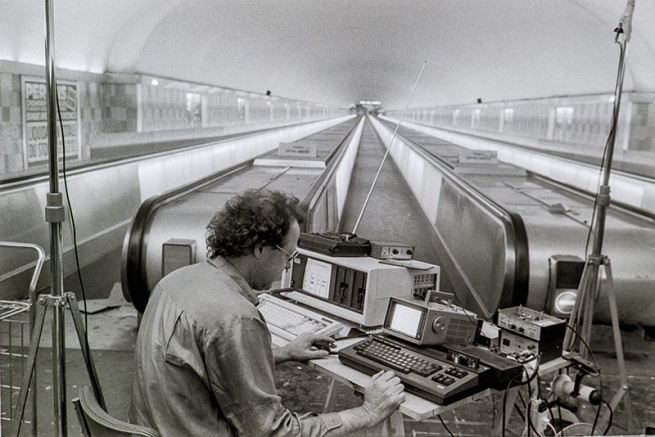
Max Neuhaus at Metro Montparnasse station, Paris, 1985. Ph. Florian Kleinefenn
From Robert Smithson to Gordon Matta-Clark, many were the artists who on those glorious days of impossible art have worked at the scale of a landscape or of a city; but by infiltrating the sound scape of the Manhattan island, Neuhaus could have been the champion of this art of intrusion. Even if we can doubt of the importance of modifying the sounds of the sirens of NY police cars, there is something unique and moving in seeing this Texan born, who easily played the part of a primitive avant-gardist, chose to develop his acoustic researches for the project inside a canyon, equating acoustically the city to the wilderness (only Howard Hawks has been able to deal with the underworld as well as with western atmospheres). A one man vision, that is how Max Neuhaus work appears today, more than a collection of actions made by a revolutionary who wanted to leave open the doors of the concert hall (had not the austere Boulez himself declared in the late Sixties that opera houses should be burned?).
What happens when the inaugural piece of a career is also a masterpiece to compare every work that comes after? To leave New York for Europe was not only a clever decision but lucky for the artist. In the early 80’s, contemporary art received a new or a renewed support from institutions in Germany, Switzerland or France, it was a time of new interest for deserted castles and palaces or for gardens. Neuhaus followed the wave and was able to find inspiration and work on any kind of situation or location. The lack of taste for theory, the refuse of any inscription in the music world, was of somewhat of a handicap for him. What is the link between active listening through walks in Manhattan, sub-aquatic audio experiences and a silent alarma clock or the Max Feed (this personal home sound mixing system)? Would these pieces help to free us or to enlarge our experience and enter deeply into our conscience? Or, in a more modest way, to discover a site or a building through the movement of sounds and our move into them? Neuhaus’ work seems easier to relate to Light and Space than to conceptual art even if he shared with the later a critic of ocularcentrism. Neuhaus uses illusion ( a non-recorded and non-imitational sound, perceived as a natural presence) but uses it in order to reveal: we progressively discover that what seemed to be hear and produced by some equipment of the house, was in reality a parasitic and moving sound. People have to remember or to figure out what it was in mid 80’s to enter a very large and empty room in Kunsthalle Basel, to sit and open our ears to what seemed to be noises produced by air conditioning or by the heating system.
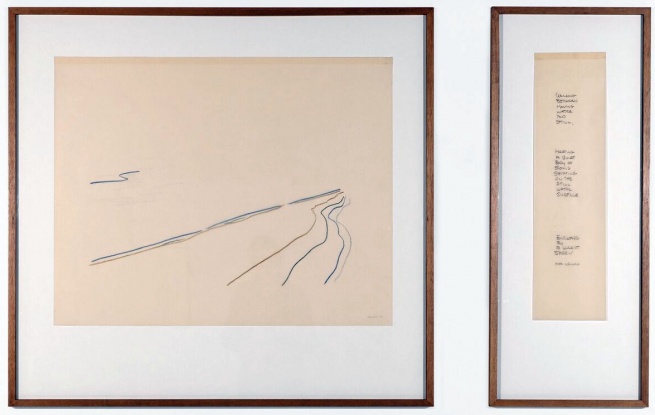
Max Neuhaus, Untitled (Domaine de Kerguehennec, Locminé), 1993, colored pencil on paper, 75 x 97 cm; 75 x 20 cm. Collection Centre national des arts plastiques. Ph. : Blaise Adilon
Among the composers Max Neuhaus was closely related during his years of "best percussionist in the world", there is one who seems to share some important ideas about audience and the musical world and that is Morton Feldman. Neuhaus has performed The King of Denmark in the stairwell of the Artists Club in Chicago. The King of Denmark, (an answer to Stockhausen’s Zyklus) is played exclusively with the fingers (Neuhaus mentioned once that it was him who made the suggestion to the composer) and requires from the interpreter a particular delicacy of touch. This delicacy of touch, this new way of playing percussion for a serious music composition, was perhaps a first step on a way to get closer to the process of sound making.
Like Feldman, but with a very different agenda, Neuhaus wanted to escape from the avant-garde music word. But for his generation it was no more a question of finding new ways for abstraction, to reinvent the musical piece as the abstract expressionist had to promote a new idea of painted canvas. This time, the new art was phenomenological and site specific. Sculpture was the word in these days (mid-seventies). . For the New York School of music, sculpture was synonymous with object and as so the enemy of process. On the contrary, for the generation of Neuhaus, sculpture could be a process, could be enlarged, and was participative. It could give to the audience the condition for a new inner experience or for a discovery of the self. Feldman, again, when he composed Rothko Chapel was making a kind of site specific work, not a musical composition inspired by the painting of Rothko, as we read so often. Against his will, Neuhaus has not been able to cut completely the link relating him to music, and the fact the he denied any originality nor creativity to the aural topographies he created for his pieces could even be argued, since he took inspiration from the existing soundscape while never allowing any kind of imitation. To describe the piece for the Arc Musée d’Art Moderne in Paris he compared it to the sound of the wind through branches and needles of pine trees; sound as a movement more than as a colour.
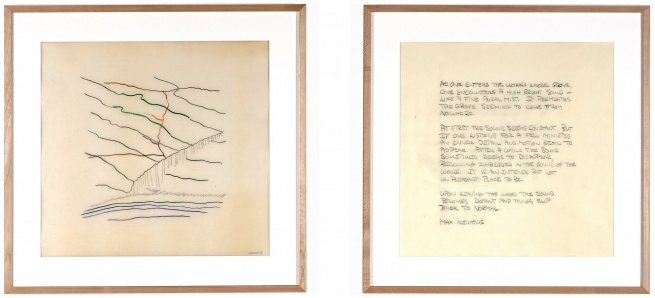
Max Neuhaus, Untitled (Lake Luzern), 1990, colored pencil on paper, 48 x 55 cm; 48 x 47 cm. Collection Fonds cantonal d'art contemporain, Genève. Ph. Blaise Adilon
Neuhaus often claimed that he has invented the notion of "soundscape" before R. Murray Shaefer published his famous book. In any case, he had a more generous comprehension of the soundscape than the Canadian theoretician who put on the fore the sound pollution of the city to project his utopian view. From his Cagean years, Neuhaus seemed to have developed some kind of love for sound, whatever it was and the sirens of the police cars were more of a challenge (as the alarm clock) to how differentiate a sound from the general soundscape other than by the volume.
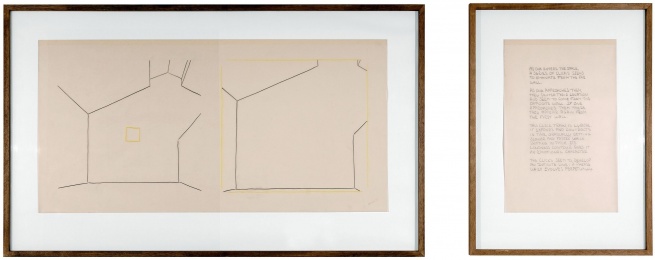
Max Neuhaus, Infinite Lines From Elusive Sources #1, 1993, colored pencil on paper, 59.5 x 121 cm; 59.5 x 40 cm. Ph. Blaise Adilon
Neuhaus was certainly not a protest artist and by modifying our perception of exhibition places he did not claim to do some kind of institutional critique. He acted more simply and more frankly, in a way. His work has its roots in avant-garde music and in abstract art, giving body to an enlargement and a new definition of esthetic experience was political enough and for a better worth. Can we not say that such a famous and revered statement as: "I work in the intervall between art and life" sounds pedantic and a bit silly compared to what was taking place in the sixties and seventies. The task of mourning the major exhibitions and major installations of these decades seems to have no end.
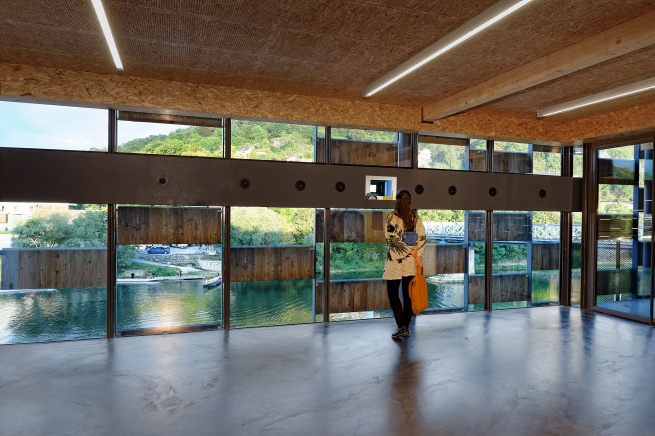
Seth Cluett, Aperture is flexible: in media res, 2016, site-specific installation, 8 speakers, acrylic sheet, 8 channels sound, custom designed software. Production: Frac Franche-Comté. Courtesy the artist. Ph.: Blaise Adilon
Max Feed brings together a possible portrait of Max Neuhaus (the occasion to discover that the list of words Neuhaus used to make to explain his works could be related to some poetry) and gives us a way to see the deep changes in the art world through the presence of sound. As a musician and creator of installations, Seth Cluett could be considered one of the inheritors of Max Neuhaus, but one of the pieces he presents in the show is closer to a movie for the ears, dealing with superposition of planes and an equation between sound layers and visual planes. By segmenting a landscape in layers and by diffracting the sounds on different planes, this could be named landscape reading or analytical reading of landscape.
Oleg Tcherny focuses on the movements of leaves in the surroundings of Princeton University. Surreptitiously we see that the museum is hosting a show named: "Land Art today", a clue or a starting point maybe for this meditation.We see and hear leaves falling, blown by the wind or by the city gardeners with nor in chronological or logical order but with a musical editing, sometimes even with the repetition of the same fixed image (as a remembering of film as physical material) or with some accelerations that create continuous lines. An elegy to moving image (From Muybridge to Lumière) as to the recording of sounds. Framed between a short sequence with a train arriving and another one with a train departing...It seems that a lot of the city sounds are missing: voices, music, car engines (motors?) in order to concentrate our attention on the dialogue between man-machine and leaves, to make us aware on the way to fix a sounds on the moving images, on the work of cinema itself. The very rare digital cinema effects brings back distant memories of Vertov. How to film today the ordinary, the non-remarkable. Combination of sounds and images, variations of speed, sound editing as a piece of broidery.

Max Neuhaus, Listen (Brooklyn Bridge-South Street), original poster/invitation mounted on lightbox for the exhibition, 1976
The car alarms replaced by birds cries by Nina Kadchadourian is a good example of sound installation infused with humour and anarchist spirit. In all of the mentioned cases, it is recorded sound, a far cry from abstraction. And if Trisha Donelly’s piece is probably the most intriguing, it is also the one that seems to be far from Neuhaus view and looks more like a curator’s choice.
Can we say that something is missing? A sense of perturbation, perhaps? Times Square is a beautiful half hidden figure, but other pieces like the one in Bern Kunsthalle could be disturbing. Not forgetting that one of the last major works of Neuhaus is Time Piece Stommeln, a sound installation for the Synagogue, sounding thirteen times a day during sunrise and sunset. A scansion of time that makes Neuhaus’ work forgetting avant-garde for a while and play a part in the daily life of a small city. More than being a half-hidden author’s figure, maybe Neuhaus was searching for his art a right place where to live permanently. Simple sound sequences with a sense of space, pitch, time and duration that do not have to claim that they are part of a monument.
Challenging the most stimulating and ambitious art of his time, Neuhaus refuse to compose sounds was a double claim: that sound art could be considered as equivalent as visual art, that sound art should not be a manipulation of any kind, the movement of sound counting more than the music itself. How can we describe the experience we have had of a Neuhaus piece, considering the sound itself of no value? One has to be a poet maybe to say something the repercussion of sound in his deep self. To quote a word that was dear to Feldman, his work is uninfluential, but it is also a milestone for the sound art of today. That was one of the merits of this exposition to give us elements for a large and open reflexion.
* To be published by Les Presses du Réel at the end of 2017.
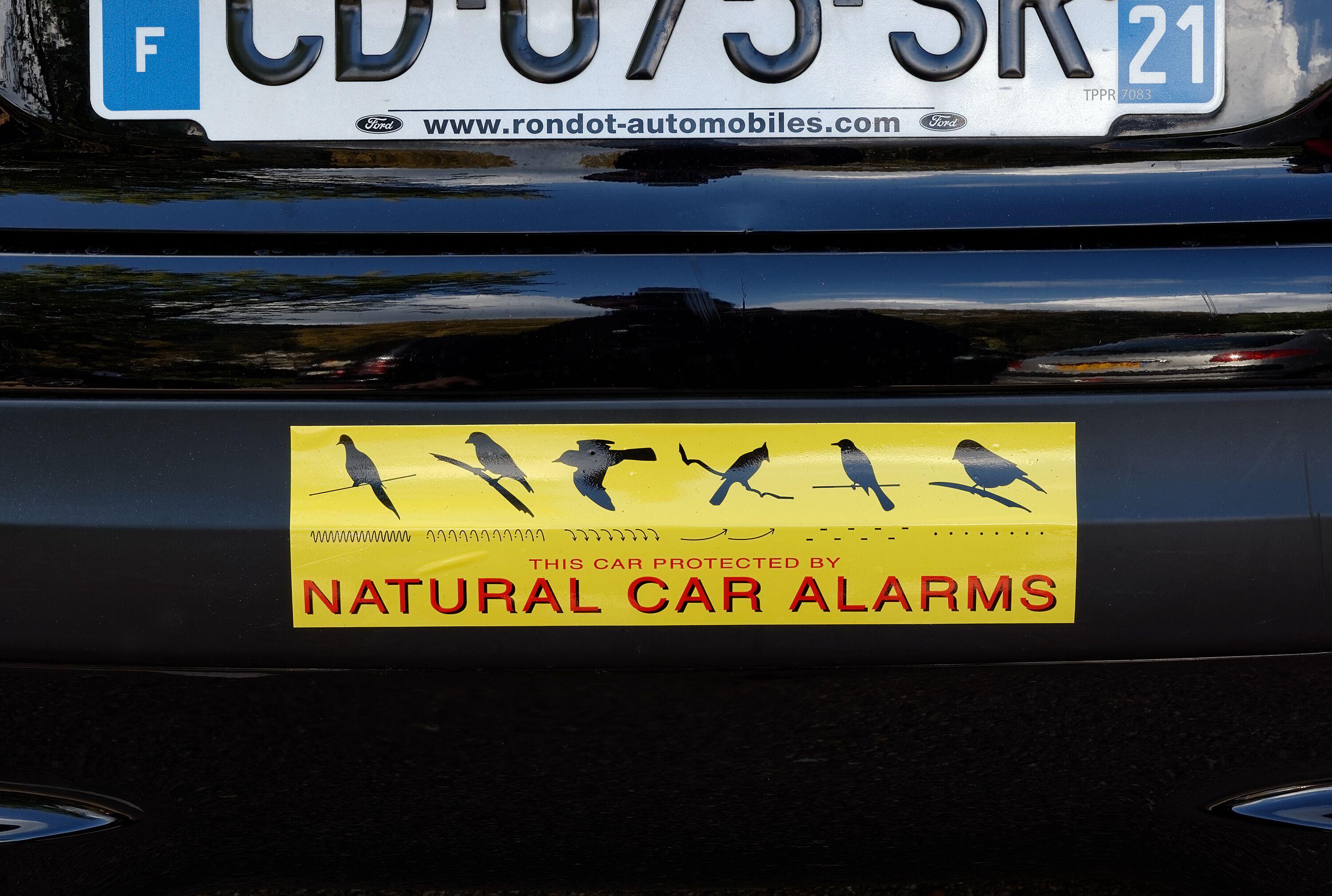









 Since 2011
Since 2011 

